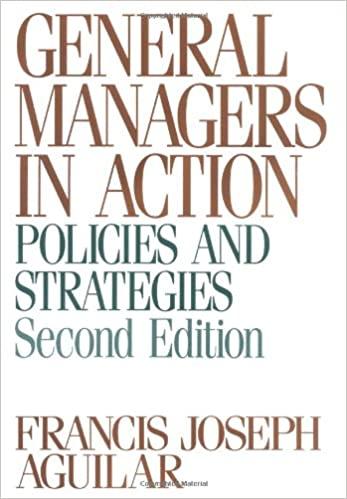Answered step by step
Verified Expert Solution
Question
1 Approved Answer
Page 1 of 2 The battle lines were drawn in the membership warehouse sector and the competitive intensity was ratcheting up . As Jim Brau
Page
of
The battle lines were drawn in the membership
warehouse sector and the competitive intensity
was ratcheting up As Jim Brau looked out the
airplane window through the clouds, he pondered
the charge to improve efficiency and cut costs
through logistical redesign. His flight would be
landing in a few minutes and he would be back in
the office within the hour. Jim had just completed
a tour of three Midwestern stores and was
anxious to get back to work. Jim and his re
engineering team had been given the mandate to
Provide a competitive advantage to SAMs CLUB
by having merchandize flow through the SAMs
CLUB supply chain at the lowest possible cost.
Existing Inefficiencies
To date, the team had analyzed the asis supply
chain and identified ten sources of inefficiency.
Jim knew that the challenge was to determine
how to exploit the inbound network to transform
the following inefficiencies into opportunities for
competitive advantage.
Too much freight was moving in non
truckload quantities. Freight cost analysis
revealed that TL was by far the lowcost
option. Multistop TL cost LTL
parcel and airfreight more.
Delivery options from suppliers were not
always analyzed adequately. Crossdocking
leveraged TL economies; yet, the team
wondered whether other options might be
more cost effective at times.
Despite all of Sams Clubs efforts, empty
backhauls were still prevalent. WalMart
also suffered from empty backhaul
inefficiencies.
Freight imported from Asia landed almost
exclusively on the West Coast and was then
shipped by truck to DCs and individual
stores. Everyone wondered if this was the
most efficient option.
Sams Club shipped millions of pounds of
freight LTL There was no way to create
milk runs or buy certain products in larger
quantities; still, the team wondered if some
other alternative might be found.
Industry practice was to buy product with
shipping prepaid. While suppliers often
offered a shipping allowance, the question
was whether or not this was really the best
way to manage inbound freight.
Scores of carriers and thousands of routes
were used to move product from suppliers
to DCs and then on to stores. Was Sams
Club using the most efficient options,
especially with respect to shipping points?
The loss and damage bill seemed
excessive and materials handling costs
were high. Transportation costs for some
lowdensity products like garden ponds
really took a toll on profit margins.
It appeared that the impact of purchasing
decisions on transportation efficiencies was
often ignored, leading to poor capacity
utilization and excessive damage.
The team knew that a trailers capacity is
determined by weight and volume; yet, this
fact had not been taken into consideration
in defining trailer loading policies and
procedures.
Industry Background
The membersonly shopping craze began in
when the first Price Club opened in a converted
airplane hanger in San Diego, California. By
almost club stores were in operation
worldwide, most in the United States. Two
companies dominated the marketCostco and
Sams Club. Costco operated stores and
generated sales of about $ billion in
Sams Club claimed over million members,
operated over warehouse stores, and
generated sales of $ billion. Both promoted a
similar value proposition and operated using
comparable efficiencydriven business models.
Costco Sams Club
Costco is dedicated to
bringing our members
the best possible prices
on quality brandname
merchandise.
Our operating
philosophy has been
simple. Keep costs
down and pass the
Sams Club offers
exceptional value on
brand name
merchandise at
"members only" prices.
SAM'S CLUB operates
by selling merchandise
at very low profit
The Club WarThe battle lines were drawn in the membership
warehouse sector and the competitive intensity
was ratcheting up As Jim Brau looked out the
airplane window through the clouds, he pondered
the charge to improve efficiency and cut costs
through logistical redesign. His flight would be
landing in a few minutes and he would be back in
the office within the hour. Jim had just completed
a tour of three Midwestern stores and was
anxious to get back to work. Jim and his re
engineering team had been given the mandate to
Provide a competitive advantage to SAMs CLUB
by having merchandize flow through the SAMs
CLUB supply chain at the lowest possible cost.
Existing Inefficiencies
To date, the team had analyzed the asis supply
chain and identified ten sources of inefficiency.
Jim knew that the challenge was to determine
how to exploit the inbound network to transform
the following inefficiencies into opportunities for
competitive advantage.
Too much freight was moving in non
truckload quantities. Freight cost analysis
revealed that TL was by far the lowcost
option. Multistop TL cost LTL
parcel and airfreight more.
Delivery options from supplier
Step by Step Solution
There are 3 Steps involved in it
Step: 1

Get Instant Access to Expert-Tailored Solutions
See step-by-step solutions with expert insights and AI powered tools for academic success
Step: 2

Step: 3

Ace Your Homework with AI
Get the answers you need in no time with our AI-driven, step-by-step assistance
Get Started


